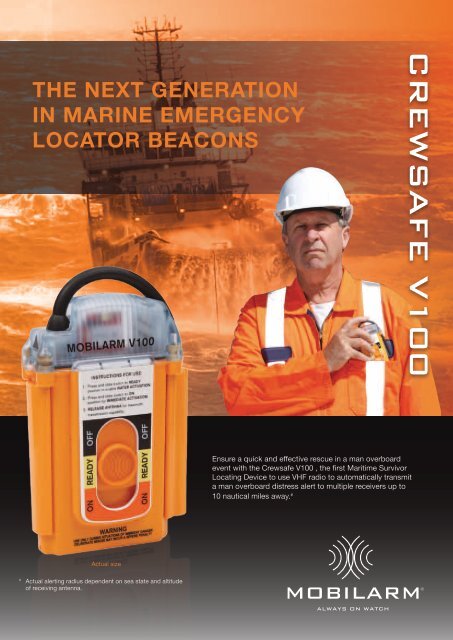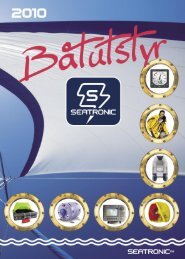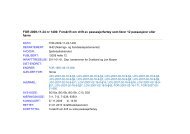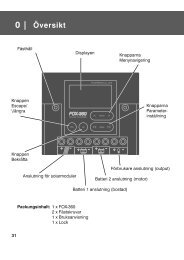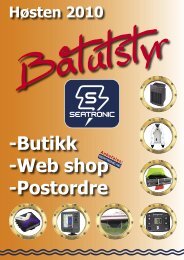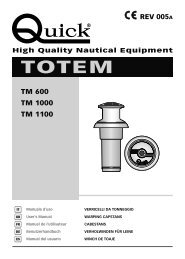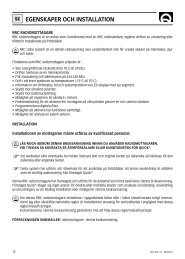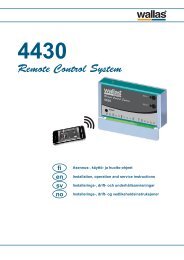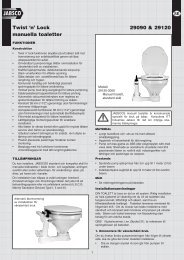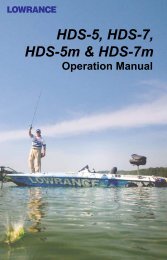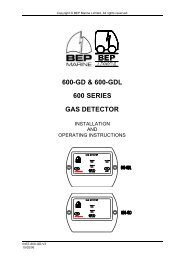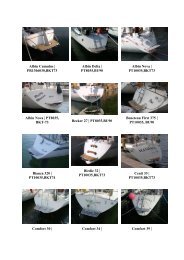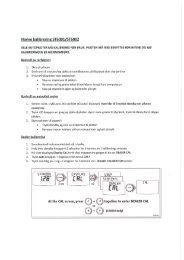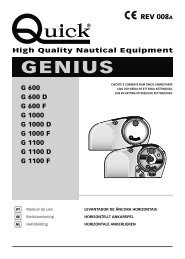Crewsafe V100 - Marine Rescue Technologies
Crewsafe V100 - Marine Rescue Technologies
Crewsafe V100 - Marine Rescue Technologies
Create successful ePaper yourself
Turn your PDF publications into a flip-book with our unique Google optimized e-Paper software.
THE NEXT GENERATION<br />
IN MARINE emergency<br />
LOCATOR BEACONS<br />
<strong>Crewsafe</strong> <strong>V100</strong><br />
Ensure a quick and effective rescue in a man overboard<br />
event with the <strong>Crewsafe</strong> <strong>V100</strong> , the first Maritime Survivor<br />
Locating Device to use VHF radio to automatically transmit<br />
a man overboard distress alert to multiple receivers up to<br />
10 nautical miles away. #<br />
Actual size<br />
#<br />
Actual alerting radius dependent on sea state and altitude<br />
of receiving antenna.
Chances of survival in a man overboard event<br />
are directly related to the length of time spent in<br />
the water. Simply speaking, the sooner you are<br />
retrieved, the more likely you are to survive.<br />
5<br />
4<br />
lethal Zone<br />
Hours in water<br />
3<br />
2<br />
MARGINAL Zone<br />
1<br />
SAFE Zone<br />
0<br />
0 5 10 15 20<br />
Sea temperature ( o C)
DUTY OF CARE IN THE<br />
MARINE WORKPLACE<br />
The unique risks to employee safety in the commercial marine workplace, such as unsteady working<br />
platforms, rough seas and poor visibility, increase the likelihood of slips and trips. This, coupled with<br />
operating alone or at night or suffering a split-second lapse of concentration during a long shift, can<br />
all be contributing factors to a fall overboard, which is the single largest cause of marine fatalities. 1<br />
While it is difficult for employers to completely remove the risk of a man overboard event occurring,<br />
how the situation is managed directly affects the outcome. Man overboard drills and procedures are<br />
frequently practiced and reviewed, employees are supplied with life vests and vessels are equipped<br />
with safety equipment. But these alone do not alert the captain or crew that someone has fallen<br />
overboard, and do not help the casualty to be found.<br />
Providing crew in an at-risk environment with the <strong>Crewsafe</strong> <strong>V100</strong> will vastly improve their chances of<br />
survival following a man overboard event by instantly alerting the captain and crew to the emergency<br />
and providing precise GPS coordinates directly to the vessel’s radio.<br />
1<br />
National <strong>Marine</strong> Safety Committee 2005-2006
how it works<br />
2<br />
gps coordinates<br />
GPS pinpoints the casualty’s position to within<br />
10 metres.<br />
Acquiring a GPS position begins immediately<br />
and as soon as a lock is obtained, current<br />
latitude and longitude coordinates are<br />
transmitted via DSC and voice message.*<br />
1<br />
water activated<br />
Inbuilt water sensors activate<br />
the device if the wearer<br />
falls overboard.<br />
Even if the casualty is<br />
incapacitated or unconscious,<br />
the <strong>Crewsafe</strong> <strong>V100</strong> will begin<br />
emergency transmission,<br />
though the device can also<br />
be manually activated.<br />
Not to scale
3<br />
vhf dsc and voice message<br />
The only equipment needed to receive the distress alert is<br />
a VHF radio.<br />
VHF DSC radios will receive the automated DSC alert first,<br />
which triggers the radio alarm, and VHF radios will pick up<br />
the voice message on channel 16.* All marine search and<br />
rescue authorities, SOLAS-compliant commercial vessels<br />
and a growing number of leisure craft are equipped with<br />
DSC-compatible VHF radios.<br />
4<br />
regular transmission<br />
The distress alert is repeated at regular intervals to track<br />
and locate the casualty in the water.<br />
An updated message is transmitted every 5 minutes in the<br />
first 30 minutes after activation, then every 10 minutes for<br />
at least 12 hours, or until the beacon is switched off.<br />
5<br />
faster rescue<br />
Only the <strong>Crewsafe</strong> <strong>V100</strong> provides the people in the best<br />
position to rescue the casualty – the crew aboard the<br />
closest vessel – with their exact location, directly and<br />
without delay.<br />
Other Personal Locator Beacons (such as 406 PLBs) only<br />
transmit an emergency signal via satellite to a land-based<br />
rescue coordination centre, which can add precious<br />
minutes or hours before rescue can begin.<br />
* Profile dependent.
A CLEAR COMMITMENT<br />
TO MARINE SAFETY<br />
The <strong>Crewsafe</strong> <strong>V100</strong> addresses the challenge of automatically<br />
detecting a man overboard event, improves recovery time<br />
and will ultimately reduce the number of lives lost because of<br />
falls overboard.<br />
This palm-sized, personal safety device can be easily<br />
incorporated into existing safety equipment regimes.<br />
The rugged, fully waterproof construction of the <strong>Crewsafe</strong><br />
<strong>V100</strong> , complete with strobe light to assist visual homing,<br />
makes it ideal for use in the harshest of marine environments.<br />
annual recertification service<br />
Your <strong>Crewsafe</strong> <strong>V100</strong> is designed and built to operate in the<br />
harshest marine environments, but annual servicing and<br />
recertification is highly recommended to ensure the effects of<br />
continuous use in such exposed conditions will not compromise<br />
the integrity of this lifesaving device.<br />
By having your <strong>Crewsafe</strong> <strong>V100</strong> inspected and recertified every 12<br />
months, you will increase its life expectancy and most importantly,<br />
be confident that you and your crew can rely on it to perform<br />
exactly as it is designed to, when you need it most.<br />
Fully Inclusive and Standard options available. See the <strong>Crewsafe</strong><br />
<strong>V100</strong> Annual Recertification Service brochure for more details.
• Automatic detection and notification of a man overboard event<br />
• Uses existing GMDSS/VHF radio infrastructure - no requirement for specialist equipment<br />
or services such as direction finding or satellites<br />
• Provides real-time position coordinates, updated and transmitted at regular intervals<br />
to all VHF receivers in range.*<br />
• Maximises a casualty’s chances of survival by transmitting a distress alert that can be<br />
received simultaneously by as many people as possible, all of whom can participate in<br />
the search and rescue effort<br />
• Cost-effective and suitable for use by any maritime organisation or individual and on any type<br />
of vessel or facility<br />
* Profile dependent.<br />
INTEGRATE THE <strong>Crewsafe</strong> <strong>V100</strong> WITH YOUR PFD<br />
The <strong>Crewsafe</strong> <strong>V100</strong> is designed to integrate easily with your<br />
Personal Flotation Device (PFD) or lifejacket so that you always<br />
have it with you whenever you wear your PFD. The device can<br />
also be attached to a harness or webbing.<br />
See the <strong>Crewsafe</strong> <strong>V100</strong> Lifejacket Integration brochure for more<br />
details or speak to your Mobilarm representative.
Mobilarm is the world’s leading brand in electronic marine safety equipment that protects and saves lives in the<br />
commercial marine workplace. Mobilarm delivers crew monitoring and alarm systems for use on vessels and in<br />
marine facilities, which generate automatic and immediate alerts in emergencies involving marine personnel.<br />
SPECIFICATIONS<br />
Operating Time<br />
Battery Life at +20°C<br />
Power Output<br />
Alerting Radius<br />
Environmental Resistance<br />
Time to First GPS Fix<br />
Minimum 12 hours emergency operation at -10°C (14°F) and longer in warmer conditions<br />
5 years service life<br />
1W (100mW during testing)<br />
2 to 10 nautical miles depending on sea state and height/altitude of receiving antenna<br />
IP68 (10 metres for 5 minutes)<br />
Typically 45 to 60 seconds<br />
ORDERING INFORMATION<br />
Part Number<br />
MOA-00200<br />
MOA-00250<br />
MOA-00252<br />
MOA-00251<br />
MOA-00253<br />
MOA-00254<br />
MOA-00201<br />
MOA-00202<br />
MOA-00203<br />
MOA-00262<br />
MOA-00263<br />
Product Description<br />
<strong>Crewsafe</strong> <strong>V100</strong> Open Loop (Australia/New Zealand only)<br />
<strong>Crewsafe</strong> <strong>V100</strong> Open Loop (International)<br />
<strong>Crewsafe</strong> <strong>V100</strong> Closed Loop (International)<br />
<strong>Crewsafe</strong> <strong>V100</strong> Closed Loop (French)<br />
<strong>Crewsafe</strong> <strong>V100</strong> Closed Loop (Spanish)<br />
<strong>Crewsafe</strong> <strong>V100</strong> Closed Loop (Portuguese)<br />
<strong>Crewsafe</strong> <strong>V100</strong> 3-Year Extended Warranty<br />
<strong>Crewsafe</strong> <strong>V100</strong> Water Sensing Extension Kit<br />
<strong>Crewsafe</strong> <strong>V100</strong> Long Wire Antenna<br />
<strong>Crewsafe</strong> <strong>V100</strong> Recertification Service – Fully Inclusive<br />
<strong>Crewsafe</strong> <strong>V100</strong> Recertification Service – Standard<br />
For full product details and information on Mobilarm products, including the <strong>Crewsafe</strong> <strong>V100</strong> Annual Recertification Service, visit www.mobilarm.com<br />
REGIONAL PROFILES<br />
The <strong>Crewsafe</strong> <strong>V100</strong> is configured with a regional profile, described as Open Loop or Closed Loop, that complies with the regulatory requirements for<br />
a particular region. The profiles address differences relating to channels and frequencies of operation, timing and destination of transmissions, and<br />
message type, category, interval and content.<br />
The Open Loop regional profile permits transmission of a VHF DSC Distress alert to All Stations and voice transmission on channel 16. The Closed Loop<br />
profile prohibits any voice transmission and only allows transmission of the VHF DSC alert as a Distress Relay to up to 8 MMSI destinations, which must<br />
be pre-programmed into the device.<br />
For more information regarding these Regional Profiles, please visit our website,<br />
www.mobilarm.com/page/regionalprofiles.html<br />
The <strong>Crewsafe</strong> <strong>V100</strong> is not a 406 PLB or EPIRB and its emergency signal will not be detected by satellites – only marine VHF transceivers in range will receive the distress alert<br />
transmitted by this device. The <strong>Crewsafe</strong> <strong>V100</strong> is a distress alert transmission device that should only be activated in an emergency. Misuse or false activation is unlawful and<br />
irresponsible, and could result in prosecution or penalty.<br />
No device is 100% fail safe nor can it guarantee safe rescue in an emergency. When activated, the <strong>Crewsafe</strong> <strong>V100</strong> broadcasts a distress alert via VHF DSC (Digital Selective<br />
Calling) and VHF voice message (if permitted) to VHF DSC and VHF radio equipped vessels or facilities within range, but requires subsequent human interaction to acknowledge<br />
and respond to the distress alert.<br />
Satellite GPS lock and in-water tracking is dependent on the extent of satellite system coverage and reception at the time and location of the emergency. The actual time and<br />
success of rescue is therefore dependent on all these contributing factors and as such, is outside the control of Mobilarm.<br />
Mobilarm Limited PO Box 1533 Applecross 6953 Western Australia<br />
Tel +61 (0)8 9315 3511 • Fax +61 (0)8 9315 3611 • Email crewsafe@mobilarm.com<br />
Design, colour, product features and specifications are subject to change without notice. All rights reserved. E&OE. ©Mobilarm Ltd 2011. CMM39.6


